Related Research Articles

The Chicago Great Western Railway was a Class I railroad that linked Chicago, Minneapolis, Omaha, and Kansas City. It was founded by Alpheus Beede Stickney in 1885 as a regional line between St. Paul and the Iowa state line called the Minnesota and Northwestern Railroad. Through mergers and new construction, the railroad, named Chicago Great Western after 1892, quickly became a multi-state carrier. One of the last Class I railroads to be built, it competed against several other more well-established railroads in the same territory, and developed a corporate culture of innovation and efficiency to survive.
The Wisconsin Central Railway Company was created in 1897 when the Wisconsin Central Railroad (1871–99) was reorganized from bankruptcy. In 1954, it reverted to the name Wisconsin Central Railroad Company. The railroad was merged into the Soo Line Railroad in 1961.

The Soo Line Railroad is the primary United States railroad subsidiary of the Canadian Pacific Railway, one of seven U.S. Class I railroads, controlled through the Soo Line Corporation. Although it is named for the Minneapolis, St. Paul and Sault Ste. Marie Railroad (MStP&SSM), which was commonly known as the Soo Line after the phonetic spelling of Sault, it was formed in 1961 by the consolidation of that company with two other CP subsidiaries: The Duluth, South Shore and Atlantic Railway, and the Wisconsin Central Railway. It is also the successor to other Class I railroads, including the Minneapolis, Northfield and Southern Railway and the Chicago, Milwaukee, St. Paul and Pacific Railroad. On the other hand, a large amount of mileage was spun off in 1987 to Wisconsin Central Ltd., now part of the Canadian National Railway. The Soo Line Railroad and the Delaware and Hudson Railway, CP's other major subsidiary, presently do business as the Canadian Pacific Railway. Most equipment has been repainted into the CP scheme, but the U.S. Surface Transportation Board groups all of CP's U.S. subsidiaries under the Soo Line name for reporting purposes. The Minneapolis headquarters are located in the Canadian Pacific Plaza building, having moved from the nearby Soo Line Building.
Soo Line may refer to:

The Minneapolis, Northfield and Southern Railway was an 87-mile (140 km) long American shortline railroad connecting Minneapolis and Northfield, Minnesota. It was incorporated in 1918 to take over the trackage of the former Minneapolis, St. Paul, Rochester and Dubuque Electric Traction Company, also known as the Dan Patch Lines. On June 2, 1982, it was acquired by the Soo Line Railroad, which operated it as a separate railroad until merging it on January 1, 1986 along with the Chicago, Milwaukee, St. Paul and Pacific Railroad.

Soo Line 2719 is a 4-6-2 "Pacific" type steam locomotive built by the American Locomotive Company (ALCO) for use on passenger trains operated by the Minneapolis, St. Paul and Sault Ste. Marie Railway. No. 2719 was used to haul the Soo Line's last steam-powered train, a June 21, 1959 round-trip excursion between Minneapolis, Minnesota and Ladysmith, Wisconsin. It was then displayed in Eau Claire, Wisconsin until 1996. It was restored and operated in excursion service from 1998 until 2013 when its boiler certificate expired. Today, the locomotive remains on display in Duluth, Minnesota.
The Lake States Transportation Division (LSTD) was a wholly owned division of the Soo Line Railroad that existed from 1986 until 1987. The bankruptcy of the Chicago, Milwaukee, St. Paul and Pacific Railroad saw Soo Line acquire its routes to add trackage between Chicago and the Twin Cities in 1985. The Interstate Commerce Commission (ICC) mandated that Soo Line must divest of some lines in the interest of preserving competition.

The Duluth, South Shore and Atlantic Railway (DSS&A) was an American railroad serving the Upper Peninsula of Michigan and the Lake Superior shoreline of Wisconsin. It provided service from Sault Ste. Marie, Michigan, and St. Ignace, Michigan, westward through Marquette, Michigan to Superior, Wisconsin, and Duluth, Minnesota. A branchline stretched northward from Nestoria, Michigan up to the Keweenaw Peninsula and terminating at Houghton, Michigan, with two branches extending further to Calumet, Michigan and Lake Linden, Michigan.
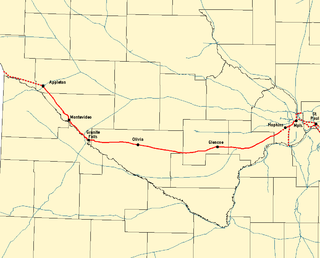
The Twin Cities and Western Railroad is a railroad operating in the U.S. state of Minnesota which started operations on July 27, 1991. Trackage includes the former Soo Line Railroad "Ortonville Line", originally built as the first part of the Pacific extension of the Milwaukee Road. This main line extends from Hopkins, Minnesota to Appleton, Minnesota. The line was originally built between Hopkins and Cologne, Minnesota in 1876 by Hastings and Dakota Railroad. In 1913, the Milwaukee Road rerouted it, reducing the curves. The line was eventually extended to the Pacific.

The Wisconsin Northern Railroad is the trade name employed by Progressive Rail to operate 62.3 miles (100.3 km) of railroad in northern Wisconsin and began operations on November 29, 2004.
The Sunflour Railroad is a short-line railroad which owns trackage in Roberts County and Marshall County, South Dakota. The company owns approximately 19 route-miles of track, between the towns of Rosholt and Claire City; the line connects with the Canadian Pacific Railway at Rosholt.
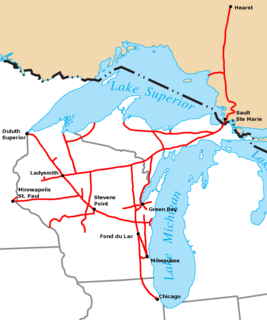
Wisconsin Central Ltd. is a railroad subsidiary of Canadian National. At one time, its parent Wisconsin Central Transportation Corporation owned or operated railroads in the United States, Canada, the United Kingdom, New Zealand, and Australia.
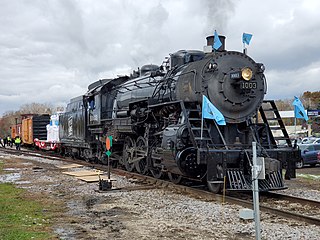
The Soo Line L-1 class was a class of ten 2-8-2 (Mikado) steam locomotives built by the American Locomotive Company in 1913 for the Minneapolis, St. Paul and Sault Ste. Marie Railway.

The Minneapolis, St. Paul and Sault Ste. Marie Railroad (MStP&SSM) was a Class I railroad subsidiary of the Canadian Pacific Railway in the Midwestern United States. Commonly known since its opening in 1884 as the Soo Line after the phonetic spelling of Sault, it was merged with several other major CP subsidiaries on January 1, 1961 to form the Soo Line Railroad.
Soo Line 2713 is an H-21 class 4-6-2 steam locomotive that was built for the Wisconsin Central Railway in May 1911. The WC had fallen under the control of the Minneapolis, St. Paul and Sault Ste. Marie Railway in 1909, and the locomotive fleets of both railroads were operated in a single pool.

Thief River Falls station is a historic train station in Thief River Falls, Minnesota. The station was built in 1913 to replace an earlier station and saw passenger traffic until 1967. It was listed on the National Register of Historic Places in 1995 as the Minneapolis, St. Paul and Sault Ste. Marie Railroad Depot and now serves as the Thief River Falls city hall.
The Bismarck, Washburn and Great Falls Railway (BW&GF) was a railroad that was organized in North Dakota on May 12, 1899. Its offices were located in Bismarck, North Dakota.
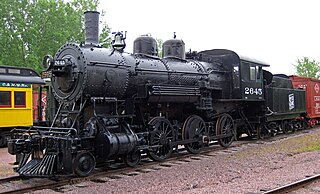
Soo Line No. 2645 is a preserved class E-25 4-6-0 "Ten Wheeler" type steam locomotive. It was built in November 1900 by the Brooks Locomotive Works as part of the E-25 class for the Wisconsin Central as No. 247. In 1909, the Wisconsin Central leased by the Soo Line Railroad, and from there on, the locomotive was renumbered 2645. No. 2645 spent its entire career in Wisconsin. Often it was stationed in Manitowoc and, Fond du Lac. The locomotive also received a class 5 overhaul in early 1952, and it was reassigned to Neenah.
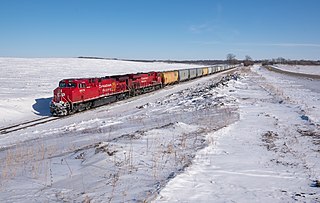
The Elbow Lake Subdivision or Elbow Lake Sub is a railway line that runs about 137 miles (220 km) from Glenwood, Minnesota to Enderlin, North Dakota. The line is currently operated by Canadian Pacific Railway (CP) under its subsidiary, the Soo Line Railroad. The rail line began construction in 1887 and was a continuation of the Minneapolis and Pacific Railway line to the Dakotas that would supply grain to Twin Cities flour mills. The line begins in Glenwood and splits with the Detroit Lakes Subdivision before going through many small towns and reaching the junction with the Morris Subdivision near Nashua. Then the line continues westward into North Dakota meeting the Veblen Subdivision at Veblen Junction. At Hankinson, the route meets the DMVW Dakota Subdivision and turns north, eventually reaching the western terminus at Enderlin.
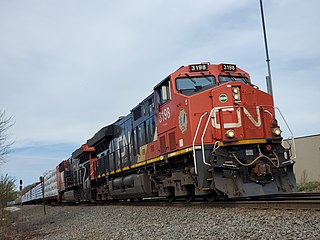
The Waukesha Subdivision or Waukesha Sub is a railway line owned and operated by the Canadian National Railway. It meets the Neenah Subdivision to the north in Fond du Lac, Wisconsin and runs south to Chicago, Illinois.
References
- ↑ "Construction News - Recent Incorporations". Electric Railway Journal . Vol. XLI, no. 1. New York: McGraw Publishing Co. January 4, 1913. p. 51 – via Google Books.
- Gjevre, John A. (1990), Saga of the Soo: West from Shoreham (2nd ed.), Moorhead, MN: Gjevre Books, pp. 120–124, LOC 90-90283
- Hufstetler, Mark; Bedeau, Michael (1998). South Dakota's Railroads: An Historic Context. Pierre, South Dakota: South Dakota State Historic Preservation Office.